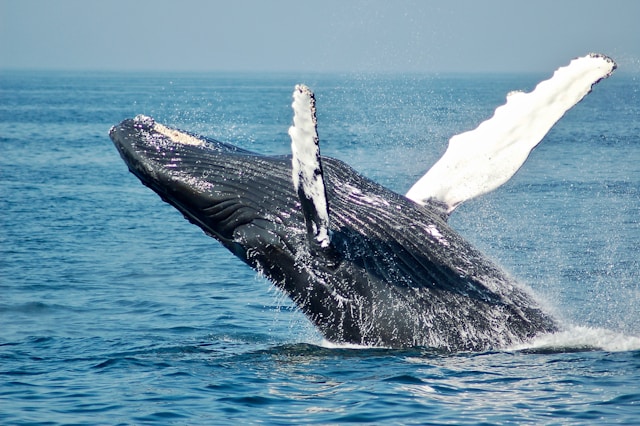Belize, known for its pristine waters and vibrant marine life, is a temporary home to the majestic humpback whales. These magnificent creatures, although not permanent residents, migrate through Belizean waters seasonally, captivating onlookers with their sheer size and graceful movements. The opportunity to witness humpback whales in their natural habitat has made Belize a hotspot for whale watching enthusiasts and conservationists alike. In this article, we delve into the wonder of humpback whales in Belize, exploring their migration patterns, the best spots for whale watching, and the ongoing efforts to protect these iconic marine giants and their oceanic environment.
The Seasonal Marvel: Humpback Whales’ Migration Patterns
Humpback whales are renowned for their impressive migratory journeys, covering thousands of kilometers between their feeding and breeding grounds. In Belize, these migratory patterns add a fascinating dimension to the marine ecosystem. The humpbacks that visit Belize are part of the Western North Atlantic population, which includes individuals from various regions such as the Gulf of Maine, Canada, and Greenland. Their migration to Belizean waters typically occurs during the winter months, aligning with the breeding season.
The journey of a humpback whale to Belize begins with their departure from colder, northern waters, where they spend the summer months feeding on krill, small fish, and plankton. As autumn arrives and the days grow shorter, signaling the onset of winter, these whales embark on their southward migration towards warmer waters for breeding and calving.
Belize’s location along the migratory route makes it a crucial waypoint for humpback whales. The warm Caribbean waters provide an ideal environment for mating and giving birth to calves. The calm and protected bays and coves along the Belize Barrier Reef offer sanctuary for these gentle giants during their time in Belizean waters.
Interestingly, humpback whales exhibit remarkable fidelity to their migration routes, often returning to the same breeding and feeding grounds year after year. This behavior, coupled with their complex and melodious songs, has fascinated scientists and researchers for decades, leading to numerous studies to understand the intricacies of humpback whale migrations.
The migration of humpback whales through Belize not only enriches the marine biodiversity of the region but also presents a unique opportunity for eco-tourism and education. Witnessing these majestic creatures in their natural habitat is a humbling experience, highlighting the importance of conserving marine environments to ensure the continued presence of humpback whales and other marine species for generations to come.
Whale Watching in Belize: Where and When to Catch a Glimpse
Belize offers exceptional opportunities for whale watching, allowing enthusiasts to witness the awe-inspiring presence of humpback whales in their natural habitat. Understanding the optimal locations and timings enhances the chances of a memorable encounter with these magnificent marine mammals.
The southern waters of Belize, particularly around the Placencia Peninsula and the Gladden Spit Marine Reserve, are renowned for their humpback whale sightings. The Gladden Spit area, in particular, serves as a critical habitat for humpback whales during their breeding season. Its nutrient-rich waters attract large numbers of fish, creating a feeding ground that humpbacks frequent, making it an ideal spot for whale watching excursions.
The best time for whale watching in Belize coincides with the humpback whales’ migration season, typically from December to April. During these months, humpbacks can be spotted breaching, tail-slapping, and engaging in other spectacular behaviors as they navigate the Belizean waters. Local tour operators and guides with expertise in marine wildlife can provide valuable insights and assistance in planning whale watching expeditions, ensuring a safe and rewarding experience for visitors.
In addition to the Placencia area, other regions along the Belize Barrier Reef, such as Ambergris Caye and Caye Caulker, also offer occasional humpback whale sightings. While sightings are not guaranteed due to the unpredictable nature of wildlife, the allure of encountering these majestic creatures amidst Belize’s pristine marine environment is a compelling reason for enthusiasts to embark on whale watching adventures.
Whale watching tours in Belize often combine opportunities to observe humpback whales with snorkeling or diving excursions, allowing participants to explore the vibrant underwater world of coral reefs and marine life. This integrated approach to eco-tourism promotes conservation awareness and appreciation for the interconnectedness of marine ecosystems, making whale watching in Belize not just a recreational activity but also a means of fostering environmental stewardship.
Conservation Efforts: Protecting Humpback Whales and Their Habitat in Belizean Waters
The presence of humpback whales in Belizean waters underscores the importance of conservation efforts to safeguard these iconic marine species and their habitat. Recognizing the vulnerability of humpback whales to various threats, initiatives focused on conservation and protection have gained significance in Belize’s marine conservation agenda.
One of the primary conservation measures for humpback whales in Belize is the establishment of marine protected areas (MPAs) such as the Gladden Spit Marine Reserve. These designated areas provide critical habitat protection during the whales’ breeding and calving seasons, minimizing disturbances from human activities and preserving essential feeding grounds.
Collaborative research efforts between local conservation organizations, government agencies, and international partners play a vital role in monitoring humpback whale populations in Belizean waters. Through scientific studies, researchers gather data on whale behaviors, migration patterns, and population dynamics, contributing valuable insights to conservation strategies and management plans.
Community engagement and education programs are integral components of humpback whale conservation in Belize. By raising awareness among local communities, fishers, tour operators, and visitors about the importance of respecting marine wildlife and adopting sustainable practices, conservation advocates strive to reduce human impacts on humpback whales and their environment.
Regulatory measures, such as guidelines for responsible whale watching practices and vessel traffic management in humpback whale habitats, aim to minimize disturbances and mitigate potential threats to these gentle giants. Enforcement of regulations and adherence to ethical guidelines by tour operators and marine enthusiasts further contribute to the protection of humpback whales and their natural behaviors.
Overall, the collaborative efforts of conservation organizations, government agencies, local communities, and eco-tourism stakeholders are essential pillars in ensuring the long-term conservation of humpback whales and maintaining the ecological balance of Belize’s marine ecosystems. By fostering a harmonious coexistence between human activities and marine wildlife, Belize continues to be a beacon of marine conservation excellence, setting an example for sustainable marine tourism practices worldwide.
Final Thoughts
The presence of humpback whales in Belizean waters is a testament to the rich biodiversity and ecological importance of this Caribbean paradise. As we reflect on the marvel of these majestic creatures and the efforts dedicated to their conservation, several key takeaways emerge.
Firstly, humpback whales’ seasonal migration through Belize underscores the interconnectedness of global marine ecosystems. Their journey serves as a reminder of the critical role that healthy oceans play in supporting migratory species and sustaining marine life diversity.
Secondly, the opportunities for whale watching in Belize offer more than just recreational enjoyment; they promote conservation awareness and environmental stewardship. By witnessing humpback whales in their natural habitat, visitors gain a deeper appreciation for marine wildlife and the need to protect their fragile ecosystems.
Thirdly, conservation efforts, including marine protected areas, research initiatives, community engagement, and regulatory measures, are fundamental to ensuring the continued presence and well-being of humpback whales in Belize. These efforts not only benefit humpbacks but also contribute to the overall health and resilience of marine ecosystems.
In conclusion, the allure of humpback whales in Belize extends beyond their impressive size and behaviors; it embodies a shared commitment to conservation, sustainability, and the preservation of natural wonders for future generations. As we celebrate the marvel of humpback whales in Belize, let us also reaffirm our dedication to safeguarding our oceans and the magnificent creatures that call them home.




